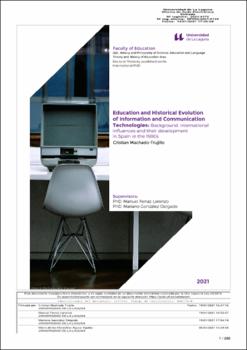Education and historical evolution of information and communication technologies: background, international influences and their development in Spain in the 1980s.
Fecha
2021Resumen
This doctoral thesis, made up of published works, develops a historical analysis of the introduction of Information and Communication Technologies (ICT) into the educational system of Spain. The many innovations that have taken place in the development of digital tools has produced great transformations in all social spheres, and especially in educational systems. In reviewing the bibliography on ICT and Education we find massive numbers of scientific publications, but most of these are on topics related to the use of such devices to improve teaching and learning processes, or to the development of Educational Technology as a disciplinary field. This research sets out other objectives, trying to analyse the fundamental issues that led a specific technological tool - the first personal computer - to be introduced massively into schools all over the world, even when it was still an incipient and little-used device. We believe that in order to understand current digitalization we must look at the first incursions of ICT into educational systems, analysing and tracking the first programmes that were developed and the arguments used
in justifying them.
Since the 1950s, with the appearance of teaching machines and following the behavioural theory proposed by Skinner, the fundamental role of the mass media and the emerging ICTs in the modernisation of educational systems has been a subject of debate. With the development of the first personal computers starting at the end of the 1960s, and the reduction in size and cost in relation to previous models, the potential of these tools for use in the classroom first began to be appreciated. This innovation occurred at the same time that access to education began to become effective for all social sectors, and when transnational bodies such as UNESCO, the OECD and the World Bank, among others, were stressing the fundamental importance of modernising education systems in order to
spur economic development. To this end, technologies such as radio, cinema and television were considered the ideal tools, a realm a few decades later was taken over by the computer. Given this scenario, it was not only the large organisations and state governments that saw the opportunity to implement programmes for development where the computer was the fundamental element; the computer industry also saw a virtually infinite business niche in the national education systems. All of this led to the alignment of many interests and initiatives during the 1980s, resulting in an infinite number of state programmes that introduced computers into schools.
The Spanish case was by no means an exception. At the end of the sixties, Spain, still under Franco's dictatorship, began to implement various policies in an attempt to promote economic development. In 1968, it received a team of expert consultants led by members of the UNESCO who strongly recommended undertaking a structural reform of the
education system, and what ultimately became the General Education Law of 1970 began to take shape. This reform, advised and financed largely by the UNESCO and the OECD, was the result of a series of close contacts between these bodies and Spain. It was in this context that the UNESCO itself recommended that the first pilot project proposed for the use of computers to improve teaching and learning processes (in this case for initial teacher training) be carried out in Spain. The programme was intended to be a first experiment, one whose results would then be exported to other developing countries.
After this first initiative, at the beginning of the 1980s, and especially starting in 1983, a new programme was planned which had as one of its main objectives to provide schools with computers and encourage their use to improve the efficiency of teaching and learning. Atenea, as it was finally called, was developed between 1985 and 1989, and was
the first major state initiative to provide schools with extensive computer equipment, a measure that was also meant to spur on the Spanish industry in this sector. The results were questioned and disputed at length but, in general terms, the conclusions arrived at were similar to those of programmes being implemented in other countries at the same time: there were no great advances in terms of improving educational processes, and, in most cases, political and economic interests were placed above pedagogical criteria. The gap between curricular contents and educational software, the limited computer skills of the teaching staff — only logical if we take into account that the expansion of its commercialisation in Spain began in 1984— and the fact that the administrations relegated it to the teachers’ voluntary initiative were some of the key conditioning factors of the results. Larry Cuban (2001) concluded that these programmes had failed across the board, and although the sales of computer products increased greatly, their use in schools was quite insignificant.
The interesting thing about the study of these initiatives and of the background that led to this shift in education towards ICT and digitalisation was that the arguments and interests that have historically been put forward to support their use have not changed significantly from these early programmes in the middle of the last century to the present day. Therefore, the need for critical study and analysis of the use of ICT in education is fundamental to avoid falling into the instrumentalization of education and ending up with it being exclusively at service of political and economic interests.






